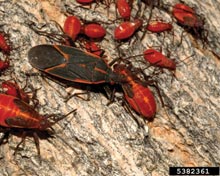
William M. Ciesla, Forest Health Management International
Boxelder Bug
General Description
Adult boxelder bugs (Boisea trivittata, also known as Leptocoris trivittatus) are about one-half of an inch long,
oval in shape, black in color with red-orange markings including three stripes behind the head. Nymphs (young)
have red-orange bodies with black wing pads, and are often found with the adults. Boxelder bugs are found on
trees, rocks, woodpiles and structures in autumn when the bugs aggregate before seeking shelter for the winter.
Large numbers can be seen taking in the sun on warm, exterior walls, and/or trying to enter structures beneath
siding, around window frames, vents, and any other cracks/gaps in the structure. Bugs that get inside will spend
the winter in wall voids, window frames, attics, basements and other protected spots. While they may look
menacing, boxelder bugs rarely bite. However, their feces can stain fabrics, walls and carpets, and smashed bugs
emit a foul odor. Long, warm autumns and mild winters give rise to large populations of boxelder bugs in spring.
Warmed by the structure’s heat, the bugs emerge sluggishly on warm days in late winter or early spring to seek
their favorite food: juices from the leaves, twigs and seeds of seed-bearing Boxelder Trees. While boxelder
bugs sometimes feed on the seed pods and fruits of other types of plants and trees including maples,
occurrences of large numbers of the bugs are usually associated with boxelder trees.
General Control
When boxelder bugs congregate around structures in fall, they should be dispersed because the bugs release
chemical scents that attract more boxelder bugs to the site. A water hose or pump sprayer will work for this
purpose, applying water, insecticidal soap, or pesticide. Sealing cracks and gaps in a structure’s foundation and
exterior walls can help keep the bugs out.









